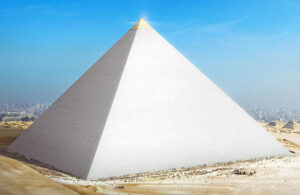The Pyramid of Khafre was initially completed in 2560 BCE. It featured a white limestone casing and a peak constructed of solid gold.

For numerous millennia, the pyramid remained largely unchanged. However, in 1303, a powerful earthquake struck the region, causing significant damage to the structure. The quake also resulted in tsunamis that inflicted severe harm and loss of life in Crete and Alexandria.
Taking advantage of the damage inflicted by the earthquake, the local inhabitants utilized their basic tools to dismantle the dislodged limestone blocks. These blocks were subsequently repurposed in the construction of mosques and fortifications, commissioned by a local Sultan. Regrettably, the golden cap at the pyramid’s peak was also pilfered and subsequently vanished.
As a consequence of the absence of its white limestone shell, the pyramid lost its ability to reflect sunlight and remain visible from great distances.
It’s not known when the rest of the casing stones were robbed; they were presumably still in place by 1646, when John Greaves, professor of Astronomy at the University of Oxford in his Pyramidographia, wrote that, while its stones were not as large or as regularly laid as in Khufu’s, the surface was smooth and even free of breaches or inequalities, except on the south.
The pyramid was first explored in modern times by Giovanni Belzoni on March 2, 1818, when the original entrance was found on the north side. Belzoni had hopes of finding an intact burial but the chamber was empty except for an open sarcophagus and its broken lid on the floor.
sourced – Wikipedia & Time Capsule Tales






